engine FORD E SERIES 2004 4.G 7.3L Diesel Supplement Manual
[x] Cancel search | Manufacturer: FORD, Model Year: 2004, Model line: E SERIES, Model: FORD E SERIES 2004 4.GPages: 56, PDF Size: 0.43 MB
Page 12 of 56
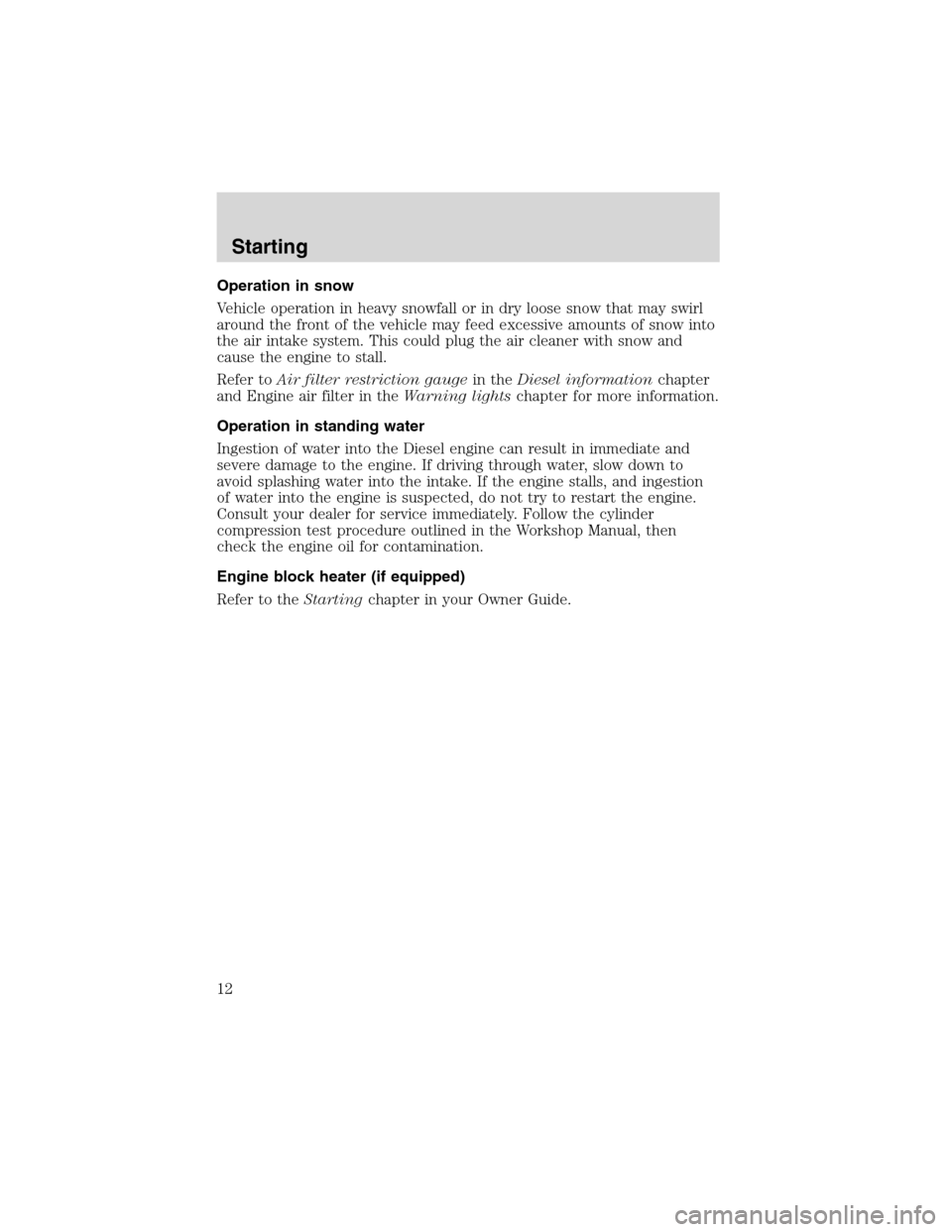
Operation in snow
Vehicle operation in heavy snowfall or in dry loose snow that may swirl
around the front of the vehicle may feed excessive amounts of snow into
the air intake system. This could plug the air cleaner with snow and
cause the engine to stall.
Refer toAir filter restriction gaugein theDiesel informationchapter
and Engine air filter in theWarning lightschapter for more information.
Operation in standing water
Ingestion of water into the Diesel engine can result in immediate and
severe damage to the engine. If driving through water, slow down to
avoid splashing water into the intake. If the engine stalls, and ingestion
of water into the engine is suspected, do not try to restart the engine.
Consult your dealer for service immediately. Follow the cylinder
compression test procedure outlined in the Workshop Manual, then
check the engine oil for contamination.
Engine block heater (if equipped)
Refer to theStartingchapter in your Owner Guide.
Starting
12
Page 13 of 56
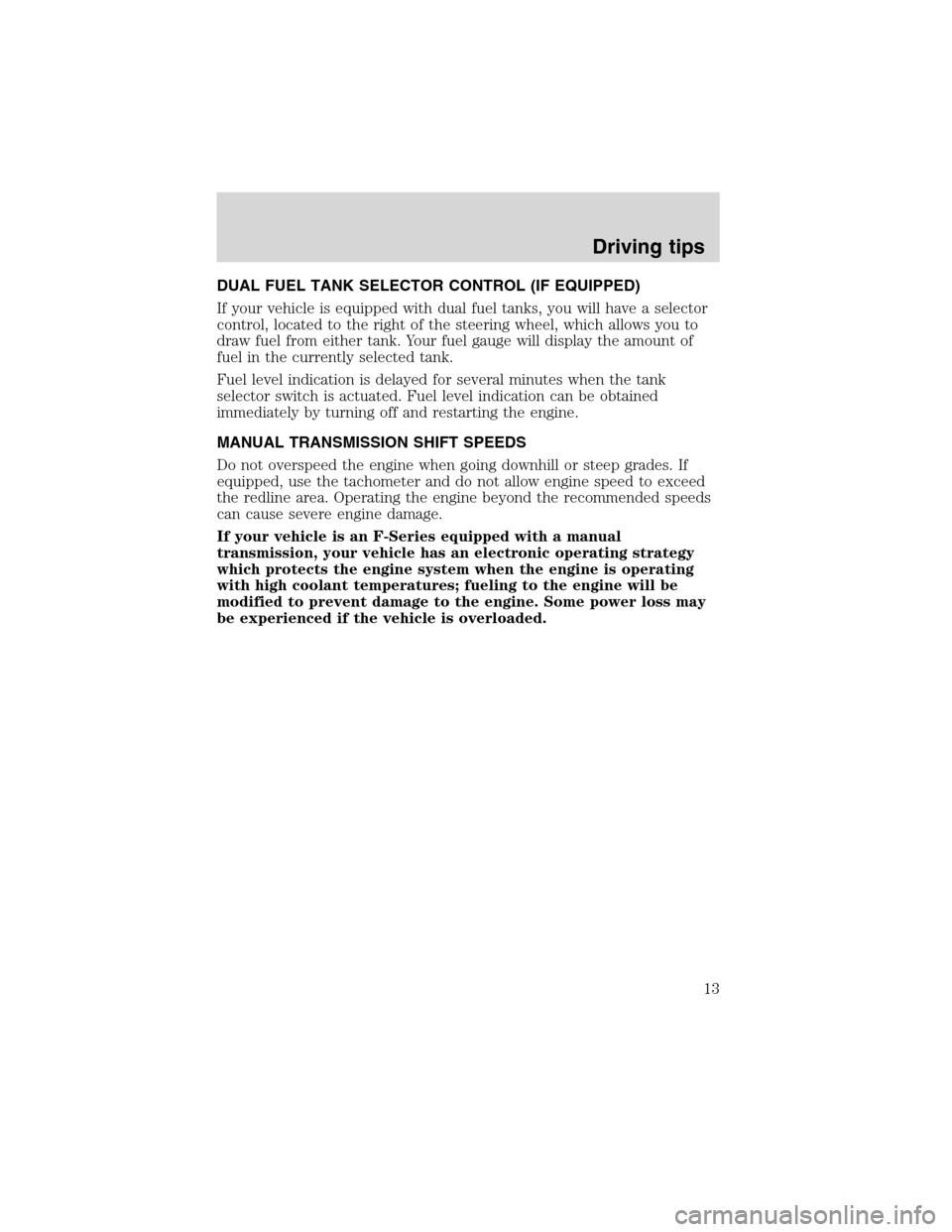
DUAL FUEL TANK SELECTOR CONTROL (IF EQUIPPED)
If your vehicle is equipped with dual fuel tanks, you will have a selector
control, located to the right of the steering wheel, which allows you to
draw fuel from either tank. Your fuel gauge will display the amount of
fuel in the currently selected tank.
Fuel level indication is delayed for several minutes when the tank
selector switch is actuated. Fuel level indication can be obtained
immediately by turning off and restarting the engine.
MANUAL TRANSMISSION SHIFT SPEEDS
Do not overspeed the engine when going downhill or steep grades. If
equipped, use the tachometer and do not allow engine speed to exceed
the redline area. Operating the engine beyond the recommended speeds
can cause severe engine damage.
If your vehicle is an F-Series equipped with a manual
transmission, your vehicle has an electronic operating strategy
which protects the engine system when the engine is operating
with high coolant temperatures; fueling to the engine will be
modified to prevent damage to the engine. Some power loss may
be experienced if the vehicle is overloaded.
Driving tips
13
Page 15 of 56

TRAILER TOWING
Refer to your Owner Guide for full details on towing a trailer.
E-Series trailer towing tables
Your vehicle may tow a class I, II or III trailer provided the maximum
trailer weight is less than or equal to the maximum trailer weight listed
for your engine and rear axle ratio on the following charts.
GCWR (Gross Combined Weight Rating)/Trailer Weights
Rear axle
ratioMaximum
GCWR-kg
(lbs.)Trailer Loaded
Trailer Weight -
kg (lbs.)Maximum Frontal
Area Of
Trailer-m
2(ft2)
E-350 Regular Van (9500 GVWR)
3.55 7258 (16000) 4400 (9700) 5.52 (60)
4.10 9072 (20000) 4536 (10000) 5.52 (60)
E-350 Regular Van (Crew) (9500 GVWR)
3.55 7258 (16000) 4309 (9500) 5.52 (60)
4.10 9072 (20000) 4536 (10000) 5.52 (60)
E-350 Extended Van (9400 GVWR)
3.55 7258 (16000) 4354 (9600) 5.52 (60)
4.10 9072 (20000) 4536 (10000) 5.52 (60)
E-350 Extended Van (Crew) (9400 GVWR)
3.55 7258 (16000) 4264 (9400) 5.52 (60)
4.10 9072 (20000) 4536 (10000) 5.52 (60)
E-350 Regular Wagon (8 passenger) (8700 GVWR)
3.55 7258 (16000) 4264 (9400) 5.52 (60)
4.10 9072 (20000) 4536 (10000) 5.52 (60)
E-350 Regular Wagon (12 passenger) (8700 GVWR)
3.55 7258 (16000) 4218 (9300) 5.52 (60)
4.10 9072 (20000) 4536 (10000) 5.52 (60)
E-350 Extended Wagon (12 passenger) (9300 GVWR)
3.55 7258 (16000) 4173 (9200) 5.52 (60)
4.10 9072 (20000) 4536 (10000) 5.52 (60)
E-350 Extended Wagon (15 passenger) (9400 GVWR)
3.55 7258 (16000) 4128 (9100) 5.52 (60)
Driving tips
15
Page 16 of 56
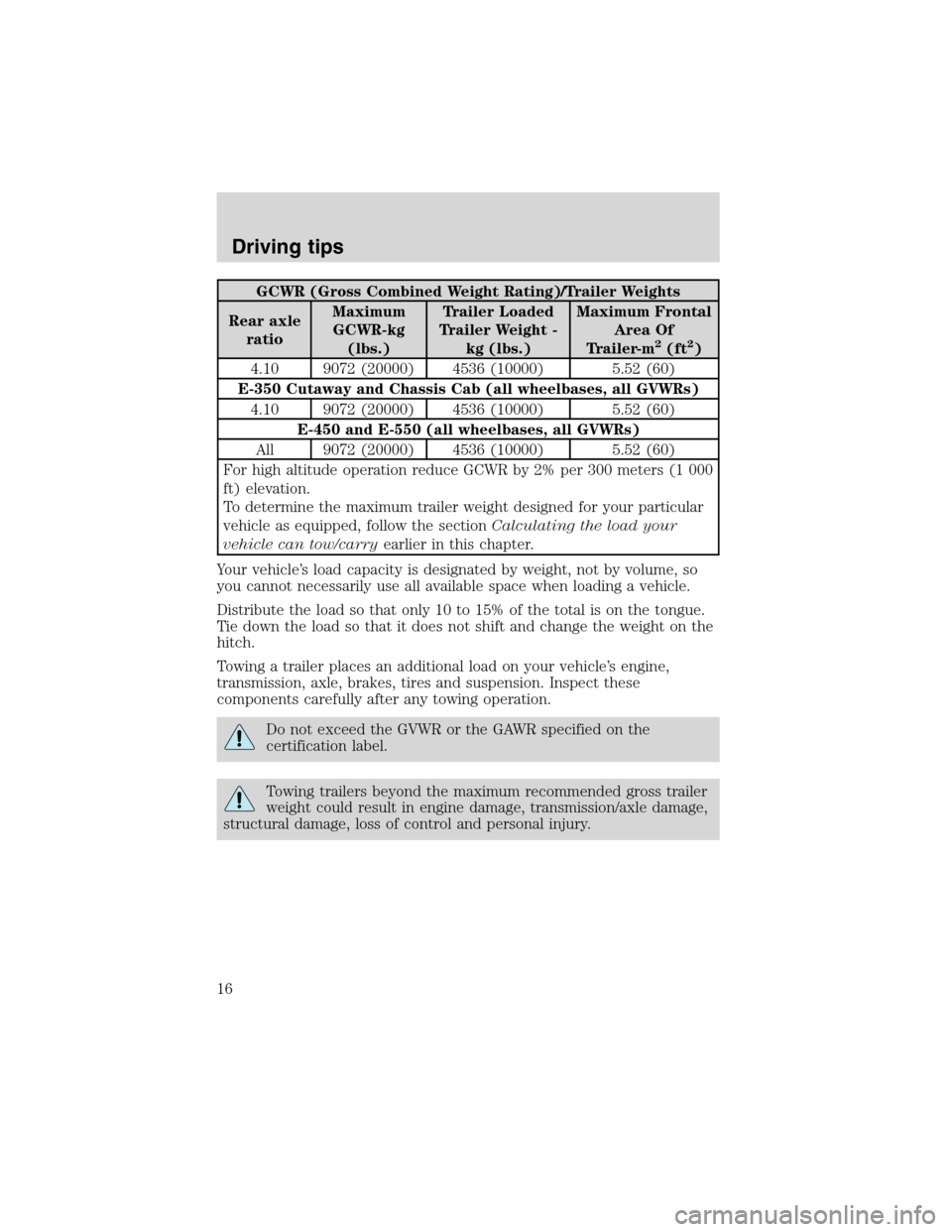
GCWR (Gross Combined Weight Rating)/Trailer Weights
Rear axle
ratioMaximum
GCWR-kg
(lbs.)Trailer Loaded
Trailer Weight -
kg (lbs.)Maximum Frontal
Area Of
Trailer-m
2(ft2)
4.10 9072 (20000) 4536 (10000) 5.52 (60)
E-350 Cutaway and Chassis Cab (all wheelbases, all GVWRs)
4.10 9072 (20000) 4536 (10000) 5.52 (60)
E-450 and E-550 (all wheelbases, all GVWRs)
All 9072 (20000) 4536 (10000) 5.52 (60)
For high altitude operation reduce GCWR by 2% per 300 meters (1 000
ft) elevation.
To determine the maximum trailer weight designed for your particular
vehicle as equipped, follow the sectionCalculating the load your
vehicle can tow/carryearlier in this chapter.
Your vehicle’s load capacity is designated by weight, not by volume, so
you cannot necessarily use all available space when loading a vehicle.
Distribute the load so that only 10 to 15% of the total is on the tongue.
Tie down the load so that it does not shift and change the weight on the
hitch.
Towing a trailer places an additional load on your vehicle’s engine,
transmission, axle, brakes, tires and suspension. Inspect these
components carefully after any towing operation.
Do not exceed the GVWR or the GAWR specified on the
certification label.
Towing trailers beyond the maximum recommended gross trailer
weight could result in engine damage, transmission/axle damage,
structural damage, loss of control and personal injury.
Driving tips
16
Page 17 of 56

Trailer towing tables
F-250
Engine Rear axle
ratioMaximum GCWR -
kg (lbs.)Maximum
trailer weight -
kg (lbs.)
Vehicles without fifth wheel
7.3L All 9072 (20000) 5670 (12500)
Regular Cab Pickup 4x2 with manual transmission and fifth
wheel
7.3L All 9072 (20000) 6260 (13800)
Regular Cab Pickup 4x2 with automatic transmission and fifth
wheel
7.3L All 9072 (20000) 6305 (13900)
Regular Cab Pickup 4x4 with manual transmission and fifth
wheel
7.3L All 9072 (20000) 6033 (13300)
Regular Cab Pickup 4x4 with automatic transmission and fifth
wheel
7.3L All 9072 (20000) 6078 (13400)
SuperCab Pickup 4x2 with fifth wheel
7.3L All 9072 (20000) 6078 (13400)
SuperCab Pickup 4x4 with fifth wheel
7.3L All 9072 (20000) 5897 (13000)
Crew Cab Pickup 4x2 with manual transmission and fifth wheel
7.3L All 9072 (20000) 5942 (13100)
Crew Cab Pickup 4x2 with automatic transmission and fifth
wheel
7.3L All 9072 (20000) 5987 (13200)
Crew Cab Pickup 4x4 with fifth wheel
7.3L All 9072 (20000) 5806 (12800)
Driving tips
17
Page 25 of 56
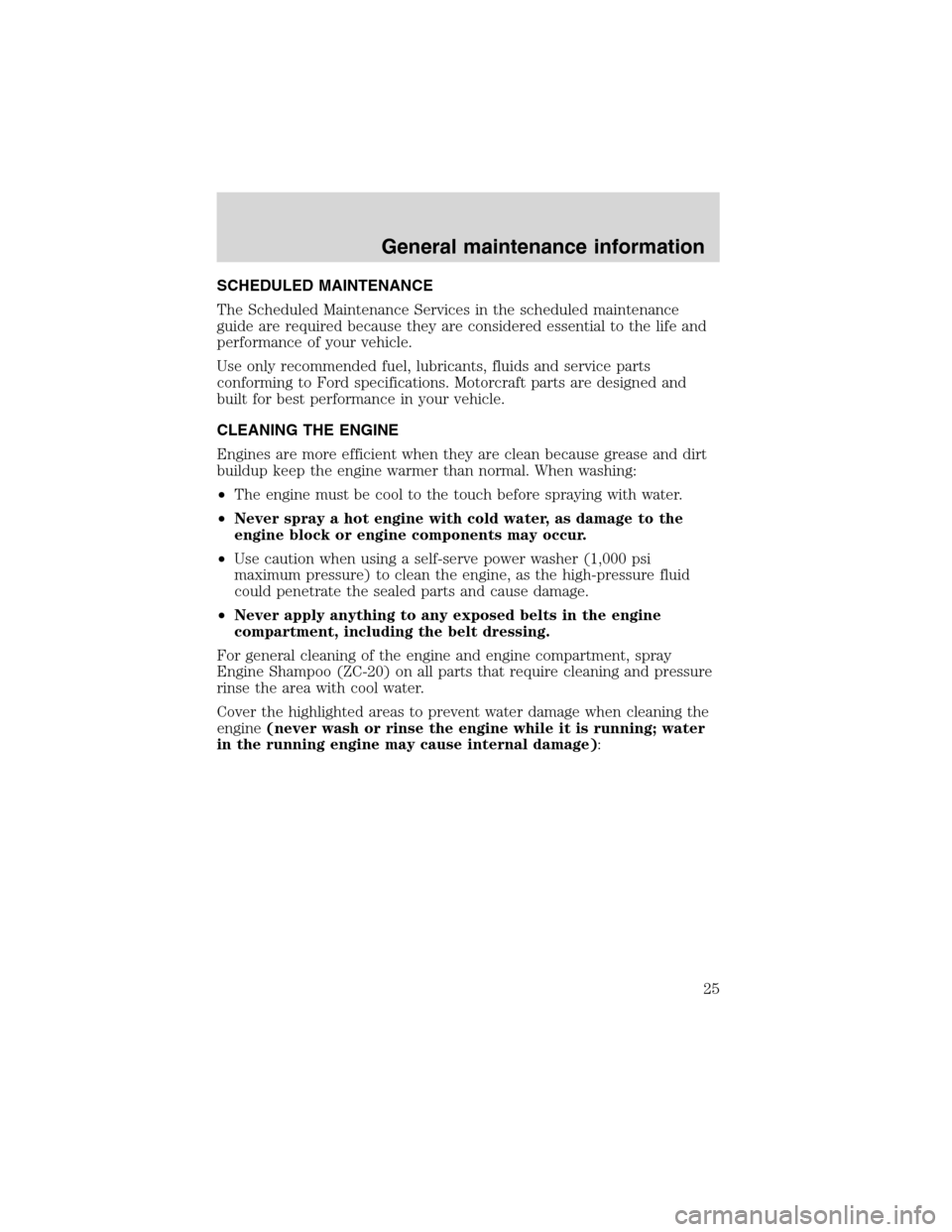
SCHEDULED MAINTENANCE
The Scheduled Maintenance Services in the scheduled maintenance
guide are required because they are considered essential to the life and
performance of your vehicle.
Use only recommended fuel, lubricants, fluids and service parts
conforming to Ford specifications. Motorcraft parts are designed and
built for best performance in your vehicle.
CLEANING THE ENGINE
Engines are more efficient when they are clean because grease and dirt
buildup keep the engine warmer than normal. When washing:
•The engine must be cool to the touch before spraying with water.
•Never spray a hot engine with cold water, as damage to the
engine block or engine components may occur.
•Use caution when using a self-serve power washer (1,000 psi
maximum pressure) to clean the engine, as the high-pressure fluid
could penetrate the sealed parts and cause damage.
•Never apply anything to any exposed belts in the engine
compartment, including the belt dressing.
For general cleaning of the engine and engine compartment, spray
Engine Shampoo (ZC-20) on all parts that require cleaning and pressure
rinse the area with cool water.
Cover the highlighted areas to prevent water damage when cleaning the
engine(never wash or rinse the engine while it is running; water
in the running engine may cause internal damage):
General maintenance information
25
Page 26 of 56
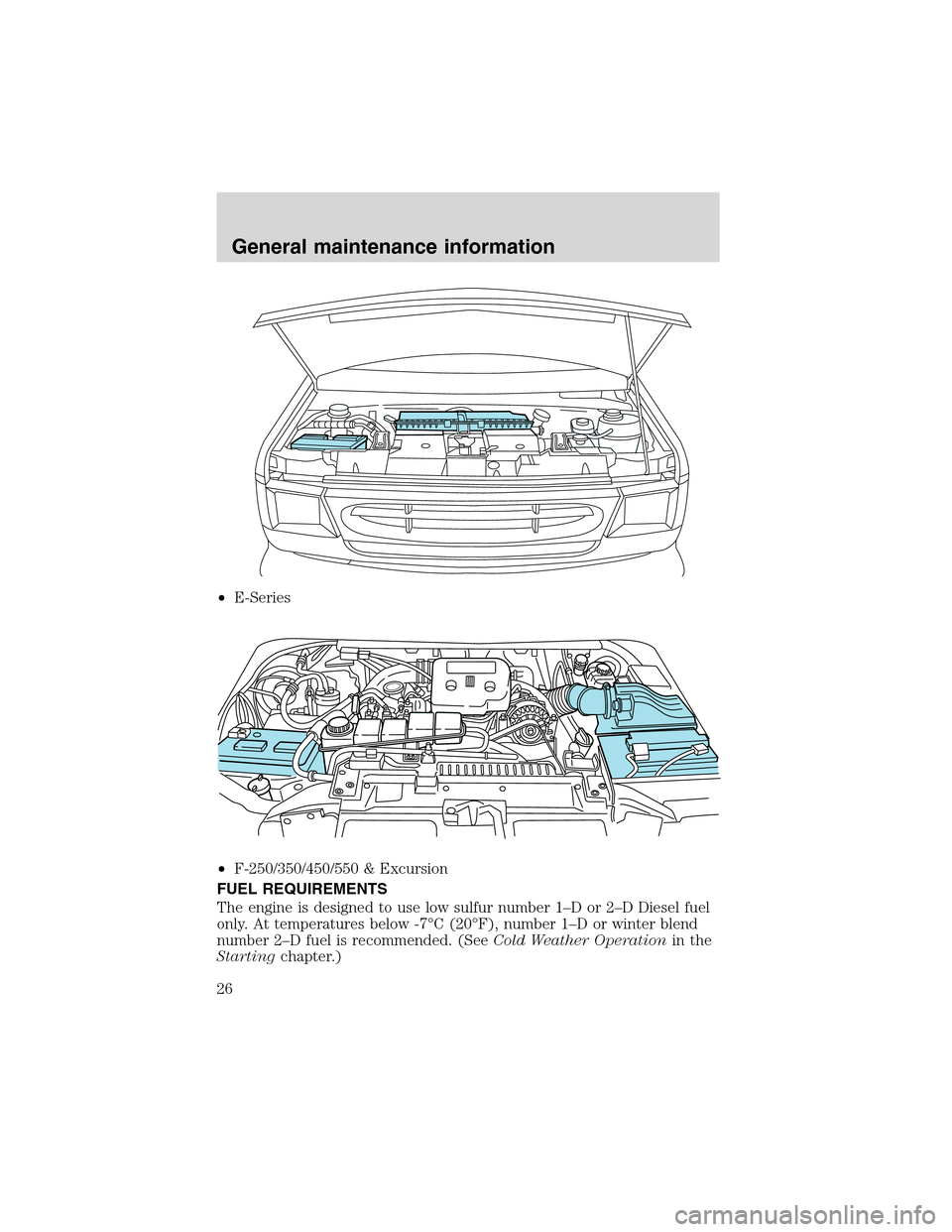
•E-Series
•F-250/350/450/550 & Excursion
FUEL REQUIREMENTS
The engine is designed to use low sulfur number 1–Dor2–D Diesel fuel
only. At temperatures below -7°C (20°F), number 1–D or winter blend
number 2–D fuel is recommended. (SeeCold Weather Operationin the
Startingchapter.)
General maintenance information
26
Page 27 of 56
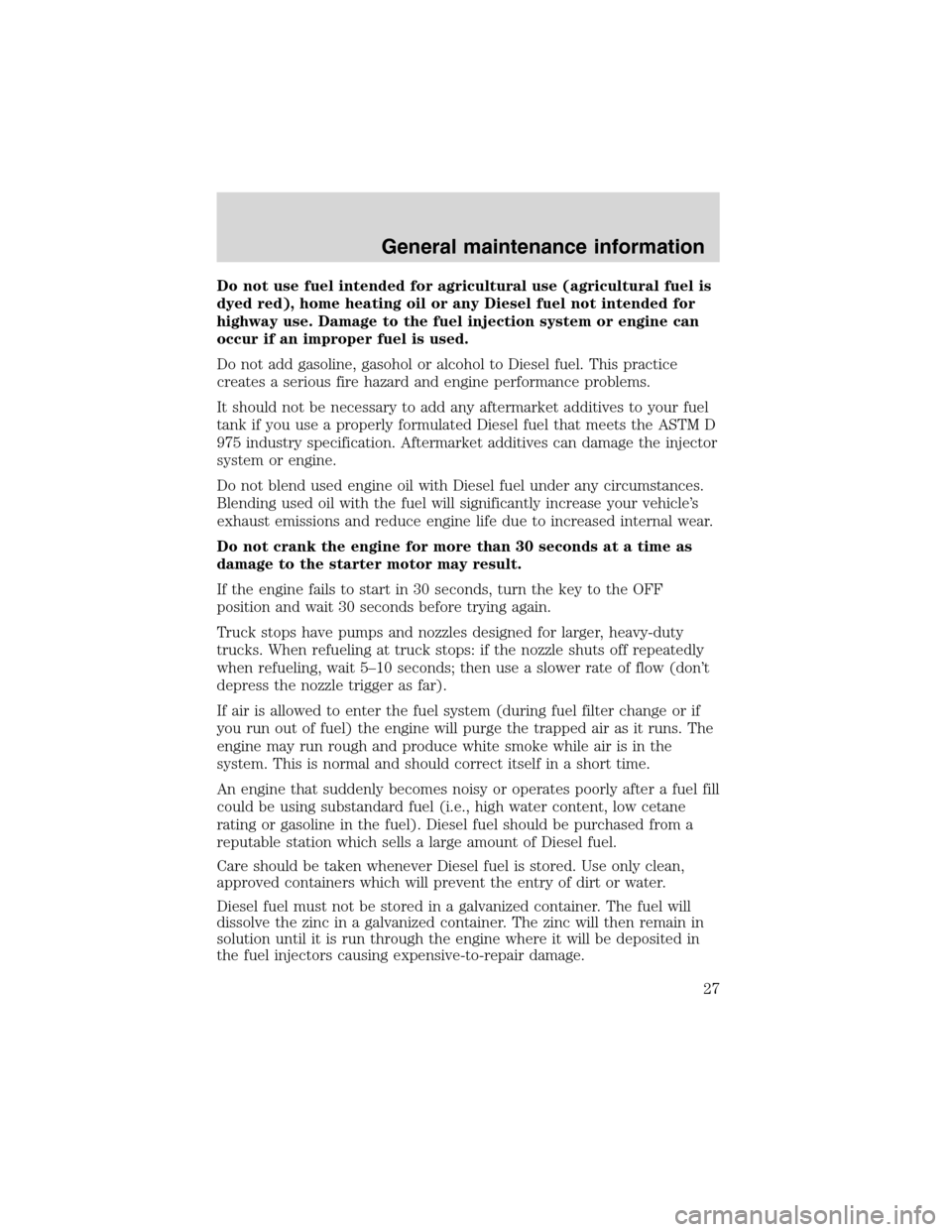
Do not use fuel intended for agricultural use (agricultural fuel is
dyed red), home heating oil or any Diesel fuel not intended for
highway use. Damage to the fuel injection system or engine can
occur if an improper fuel is used.
Do not add gasoline, gasohol or alcohol to Diesel fuel. This practice
creates a serious fire hazard and engine performance problems.
It should not be necessary to add any aftermarket additives to your fuel
tank if you use a properly formulated Diesel fuel that meets the ASTM D
975 industry specification. Aftermarket additives can damage the injector
system or engine.
Do not blend used engine oil with Diesel fuel under any circumstances.
Blending used oil with the fuel will significantly increase your vehicle’s
exhaust emissions and reduce engine life due to increased internal wear.
Do not crank the engine for more than 30 seconds at a time as
damage to the starter motor may result.
If the engine fails to start in 30 seconds, turn the key to the OFF
position and wait 30 seconds before trying again.
Truck stops have pumps and nozzles designed for larger, heavy-duty
trucks. When refueling at truck stops: if the nozzle shuts off repeatedly
when refueling, wait 5–10 seconds; then use a slower rate of flow (don’t
depress the nozzle trigger as far).
If air is allowed to enter the fuel system (during fuel filter change or if
you run out of fuel) the engine will purge the trapped air as it runs. The
engine may run rough and produce white smoke while air is in the
system. This is normal and should correct itself in a short time.
An engine that suddenly becomes noisy or operates poorly after a fuel fill
could be using substandard fuel (i.e., high water content, low cetane
rating or gasoline in the fuel). Diesel fuel should be purchased from a
reputable station which sells a large amount of Diesel fuel.
Care should be taken whenever Diesel fuel is stored. Use only clean,
approved containers which will prevent the entry of dirt or water.
Diesel fuel must not be stored in a galvanized container. The fuel will
dissolve the zinc in a galvanized container. The zinc will then remain in
solution until it is run through the engine where it will be deposited in
the fuel injectors causing expensive-to-repair damage.
General maintenance information
27
Page 28 of 56
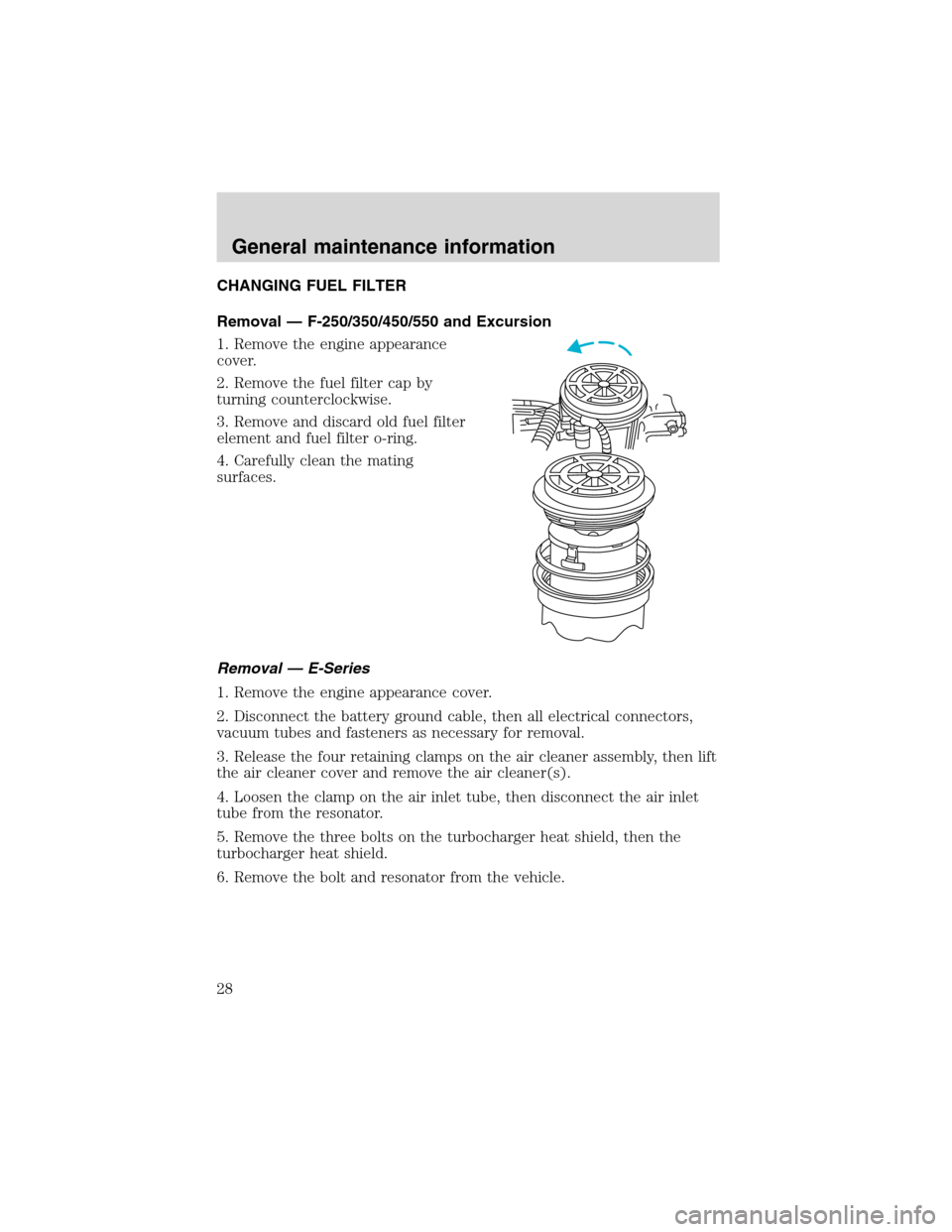
CHANGING FUEL FILTER
Removal—F-250/350/450/550 and Excursion
1. Remove the engine appearance
cover.
2. Remove the fuel filter cap by
turning counterclockwise.
3. Remove and discard old fuel filter
element and fuel filter o-ring.
4. Carefully clean the mating
surfaces.
Removal — E-Series
1. Remove the engine appearance cover.
2. Disconnect the battery ground cable, then all electrical connectors,
vacuum tubes and fasteners as necessary for removal.
3. Release the four retaining clamps on the air cleaner assembly, then lift
the air cleaner cover and remove the air cleaner(s).
4. Loosen the clamp on the air inlet tube, then disconnect the air inlet
tube from the resonator.
5. Remove the three bolts on the turbocharger heat shield, then the
turbocharger heat shield.
6. Remove the bolt and resonator from the vehicle.
General maintenance information
28
Page 29 of 56
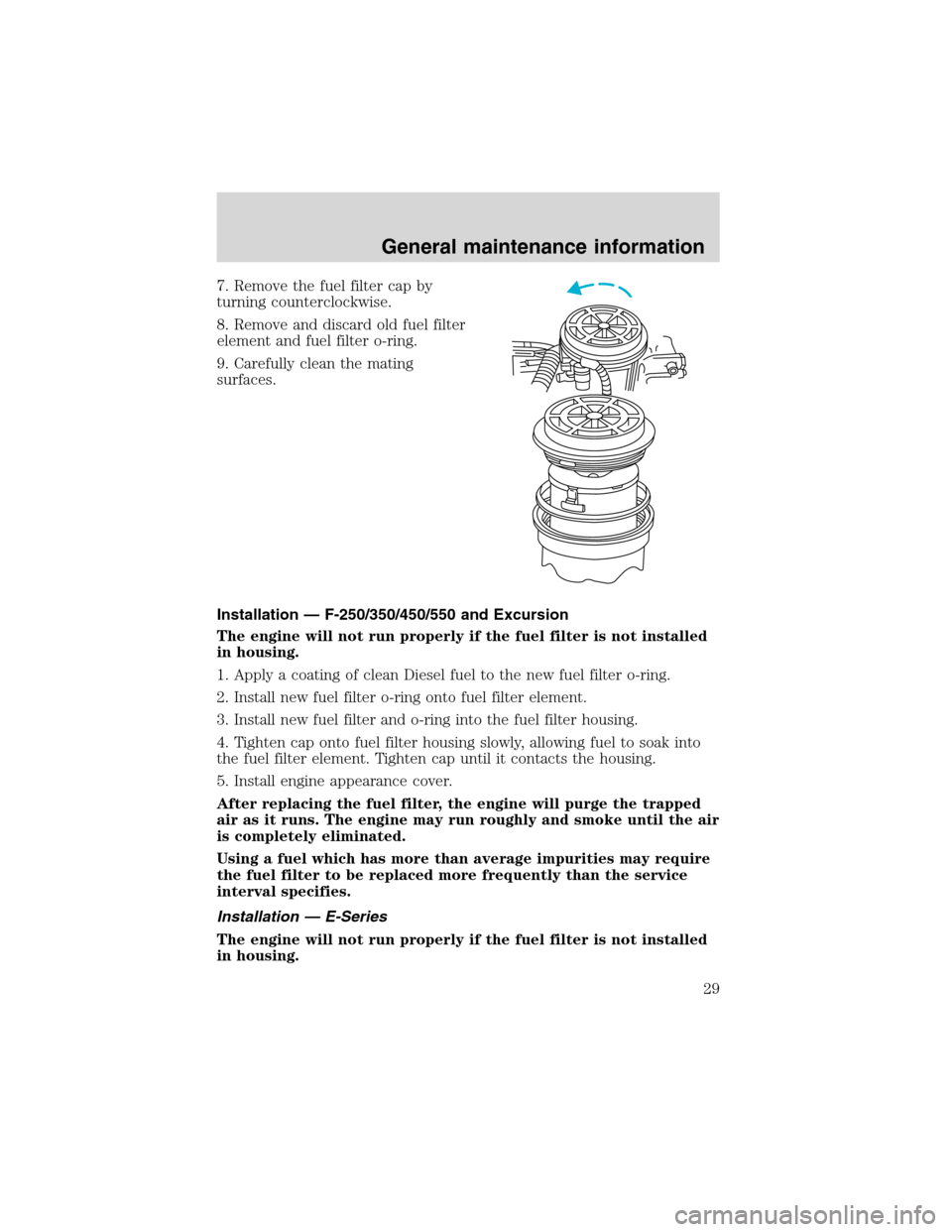
7. Remove the fuel filter cap by
turning counterclockwise.
8. Remove and discard old fuel filter
element and fuel filter o-ring.
9. Carefully clean the mating
surfaces.
Installation—F-250/350/450/550 and Excursion
The engine will not run properly if the fuel filter is not installed
in housing.
1. Apply a coating of clean Diesel fuel to the new fuel filter o-ring.
2. Install new fuel filter o-ring onto fuel filter element.
3. Install new fuel filter and o-ring into the fuel filter housing.
4. Tighten cap onto fuel filter housing slowly, allowing fuel to soak into
the fuel filter element. Tighten cap until it contacts the housing.
5. Install engine appearance cover.
After replacing the fuel filter, the engine will purge the trapped
air as it runs. The engine may run roughly and smoke until the air
is completely eliminated.
Using a fuel which has more than average impurities may require
the fuel filter to be replaced more frequently than the service
interval specifies.
Installation—E-Series
The engine will not run properly if the fuel filter is not installed
in housing.
General maintenance information
29